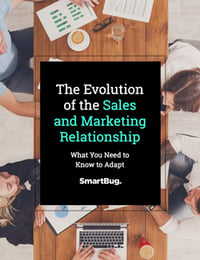
The digital marketing landscape is constantly changing, and it can feel like new strategies and tactics arise every few seconds. Just think, for example, about how artificial intelligence has taken the marketing world over by storm.
Also on the radar is the way consumers are becoming increasingly concerned with privacy. This shift is leading us toward a cookieless future, which means moving away from targeting ads based on tracking user behavior with cookies and instead using first-party data to deliver personalized experiences.
Marketers need to use their customers’ data to successfully implement paid media strategies that are evolving in a cookieless landscape. HubSpot is preparing for this change by offering tools that allow businesses to gather and utilize first-party data, such as website analytics and user behavior tracking.
We covered how digital advertising is evolving in our recent SmartTake Webinar: HubSpot Advertising & a Cookieless Future. Our panel discussion featured Crystal King, Social Media Professor at HubSpot, and Michael Birky, Paid Media Director at SmartBug Media. These experts shared their paid media expertise to educate marketers on how to prepare for a cookieless future by answering five main questions.
How has marketing data evolved to get us where we are today?
Marketing data has evolved in many ways, and it’s important to define the data being used.
Zero-Party Data
Zero-party data is the data that a customer shares with a brand voluntarily. This includes a survey or quiz that allows consumers to make informed decisions about the information they're giving. Ultimately, they're choosing to give companies the information, and then the company can decide to do certain things with that information.
For example, a skin care company might have a survey on its homepage that tells customers they can take a quiz to find out what kind of skin care regimen they might need or what type of skin they even have. Then the company can take that data and use it to target certain ads to those viewers when they're visiting the website.
Companies can also ask people for information such as phone numbers, email addresses, and demographics to find out about their consumers’ habits, lifestyles, and purchasing interests to help them with their targeting efforts.
First-Party Data
First-party data is the data that will be most important in our future. This data is owned and used by the website that a person is visiting. The purpose of collecting this data is to improve the user experience with that specific website.
“For example,” King explains, “the site might remember your username; it might remember the things that are in your shopping cart. But unlike third-party cookies, first-party cookies are not deemed essential. In other words, they're often painted as a better, more private, friendly alternative, and so this is data that you are collecting yourself.”
Second-Party Data
Second-party data is essentially a first-party list that companies receive or purchase from a trusted partner.
“For example,” Birky says, “this could be an airline sharing data with a hotel. Let's say someone goes to Tucson, Arizona, every November. An airline could share that data with the hotels in the area to encourage the hotels to offer promotions for that person so that he books with them.”
Birky goes on, “I would say, though, where you most commonly see this second-party data in use would be between B2C companies where they are sharing consumer information from one brand to another.”
Third-Party Data
Third-party data has been important to marketers in the past because, with help from tech companies, websites people visit can put a code on their devices that passes data back to the owners of the website. Third-party data exists largely to support digital advertising in companies—which means it’s great for advertisers but not for consumers.
How Data is Evolving
These third-party cookies are going away; many browsers have gotten rid of them already or will very soon. As a result, companies are losing the ability to track potential customers or leads who are navigating a company’s site and the web in general—and losing a lot of data that is typically used for retargeting. The loss of third-party data also adds a layer of complexity to audience targeting because marketers lose that insight into a prospect’s journey across the internet (e.g., they can’t easily see someone’s purchase history or browsing interests).
“By the end of 2024 is when [Google plans] to completely phase them out, so that's probably when we'll see the end of third-party cookies,” King shares. “This is super good for consumer privacy. In fact, HubSpot's blog research team found that 80 percent of consumers believe that data privacy is really important. But that leaves marketers in a bit of an, ‘Oh my god, what do I do?’ [situation].”
This shift requires marketers to rely more on first-party and zero-party data.
How can marketers use first-party and zero-party data?
Our panelists discussed a few methods marketers can use to learn about their customers, even in the absence of third-party data.
Contextual Advertising
One of the best ways to meet consumers where they are is through contextual advertising, which involves relying on data provided by social platforms. Crystal dives into the example of this:
“If you're a running company,” King explains, “you might place an ad for your sneakers alongside posts that are related to running or related to races or things like that. You might have those ads appear in YouTube videos or in newsletters or on websites related to that. Using contextual data ... works because people are assuming that you're interested in running, so therefore you might be interested in seeing an ad about running and running shoes,” King explains.
“Research by neuroanalytics company SPARK Neuro found that contextually relevant ads generated 43 percent more engagement and two times more ad recall,” King adds. “So that's pretty impressive, I think, right?”
Understanding Customers in a Deeper Way
With the third-party cookies going away, companies will need to find where their new prospects are, and this requires understanding existing customers more deeply through first-party lists.
Birky shares an example elaborating on King’s running shoes anecdote:
Without those third-party cookies to help target those ads, it might make sense for an advertiser to run ads on running-related sites and other places that runners might browse online. However, this limits our scope just a little bit, given that runners could be anywhere and we don't necessarily know the intent of where they're at if we were to just aimlessly target running sites. So there's another component here where we can utilize those contextual signals within our first-party data. This could include things like: What type of shoes are they buying? How frequently do they buy the shoes? What accessories are they looking at when they're browsing? What accessories are they purchasing? This contextual data might give us some signals and some clues that, oh, maybe person A is a marathoner, or oh, maybe person B likes to run or they like to hike in the mountains, or maybe they have things like a knee problem and they're buying inserts for their shoes from your company to help them with their joints.
By analyzing transactions and engagements using first-party data, companies will be able to create rich customer profiles and more effectively target ads toward those profiles.
Marketing Experimentation
Another way to help mitigate the loss of third-party cookies is to build a foundation on experimentation through testing different campaigns and campaign types. For example, if a company is not already doing so, it might incorporate video ads on TikTok or CTV. Or this could mean changing creative elements, such as changing a CTA to a different color.
What are the pros and cons of first-party advertising?
No marketing method is without its upsides and downsides. Here are a few of each for first-party advertising.
Pros of First-Party Advertising
The pros of first-party advertising include the following:
- It offers companies complete control and ownership. Companies gather this data based on how people browse and make purchases on their website, so there is no bias or influence from outside organizations.
- It secures user privacy and builds trust with a potential lead or customer because it is compliant with GDPR policies or the California Consumer Privacy Act. Companies do not need to worry about legal or ethical issues.
- It reduces costs because it is not being purchased through a third party.
- It increases accuracy and relevance in advertising. Companies can understand their customers and prospects on a deeper level with this accurate and reliable data.
Cons of First-Party Advertising
The panelists shared that the main con of first-party advertising is the limited scope and scale.
Birky explains, “We can only gain so much insight and depth about our existing prospects and customers within our first-party data. There's only so much we can analyze and bring in off that data ... And while it consists of contact information, purchase history, and a range of interactions on your site, it's going to take time to understand that consumer behavior and what is motivating them.”
King shares a real-world example of this limitation—and how it can become a strength:
"A few years ago [JPMorgan Chase] analyzed all of their ads, and they determined that advertising broadly with an ad network across 400,000 sites had the same effectiveness as advertising on only 5,000 pre-approved and pre-selected sites. So they determined that many of the sites that their ads were being shown on didn't have real people using them in a natural way. I'm sure you have all run across those sites where you click on some clickbait news article and then you go there and it's just all these insane ads and you can barely even manage to read the article—that's what's happening. And so JPMorgan Chase found that by really limiting that scope, that they were able to reach their audience more specifically, and by focusing on places that had real publishers and actual human audiences, that they had better outcomes and they were able to dramatically cut costs."
Despite the inherent limitations, the many pros of zero- and first-party data mean that marketers can manage cookieless ads more effectively.
How can marketers manage cookieless ads?
The shift to using cookieless ads will take some getting used to, but there are several ways marketers can adjust.
Automated Bid Strategies
Marketers can manage cookieless ads with automated bid strategies. This is a great way to save time and leverage algorithms to optimize accounts, but it must be done meticulously.
Birky encourages people who might hesitate to use automation in this way:
"A lot of people are hesitant to just turn over their dollars to Google or LinkedIn, so some people are hesitant to not just set things on manual. But really understand how you can leverage those can be wildly effective. But I say that with the caveat that ... we don't encourage anyone to ever just set it and forget it with their campaigns. Ideally you should be in a place where it's not as much work as a manual strategy, and it will really help you find the right people and know when to bid and for how much."
A/B Testing
A/B testing is another way marketers can manage cookieless ads.
“Experimentation is going to be your friend,” Birky says. “And not only with creative, but audiences as well. There's going to be times where you're coming across different target audiences or you're seeing trends within your first-party data that suggests there's another niche audience that you should be targeting.”
Companies can include different variations of an image or ad copy and test the results. There will be good and bad results at times—but even with bad results, companies are learning what works and what doesn't.
Use Social Media Data
With social media ads, companies can separate customers into segments based on interests or different demographics. Campaigns can be created to align directly with customer lifestyles.
Real-Time Marketing
Marketing in real time looks like matching ads to current events.
King says, for example, “If you sell a form of business software, you might want to run ads that are in conjunction with a specific industry trade show that your customers and your prospects might be going to.”
Geotargeting is another way to target customers. One example of how this advertising strategy would be helpful is for restaurant owners trying to reach local customers.
Cookieless Strategy Preparation
Knowing that a cookieless future is coming, companies should begin implementing marketing strategies based on other data besides third-party data. Doing so early will help prevent a gap when the third-party cookies eventually go away.
“Ultimately,” Birky says, “the goal should be getting to the point [that] when Google depreciates third-party cookies ... we don't even need third-party cookies anymore, because we're already in a place where we're utilizing first-party cookies.”
What HubSpot features help us manage cookieless ads?
Our panelists discussed some of the ways HubSpot is already prepared to help marketers make the shift to a cookieless world.
HubSpot's CRM
HubSpot’s CRM provides value to marketers by streamlining the process of managing cookieless data. With HubSpot, companies can send specific audience lists to advertising platforms that can be updated automatically and regularly, which reduces manual work and makes data a lot easier to sync. Companies can also use those lists to build lookalike audiences and identify users who have identical traits to current customers. This helps companies understand specific audience niches.
Additionally, in HubSpot, companies can identify which ads specific customers or leads engaged with and how many times they engaged with that ad, and then circle back to analyze the ad copy and creative elements to learn why that ad worked.
“HubSpot is just another piece to that puzzle that really helps us figure out and hone in on those insights and consumer traits that we might not have a clear understanding of,” Birky says.
HubSpot Cookie-Scanning Feature
There is a new cookie scanner in HubSpot. This feature is currently in beta and will allow companies to tie into the data privacy and consent settings in their HubSpot account.
“This is really great for super admins and for CMS developers who need to understand what cookies are being tracked on their site,” King shares. “What this cookie scanner does is it scans and it tracks all the cookies that have been placed upon your site, and it categorizes them into different kinds of cookies as well.”
The main purpose of this feature is for companies to control these cookies to determine if they want to get visitors’ consent to show these cookies or if they want to just block all of those cookies. After the scan, companies will be given options to do this through either blocking or setting all consent features. Additionally, it shows companies how the HubSpot cookie banner is managing all cookies on the site.
The cookieless future is bright.
By focusing on creating valuable content and building strong relationships with customers, marketers can stay ahead of the curve in the world of digital advertising. To watch the full video on demand and hear more about using HubSpot and zero- and first-party data, click here.
If you are interested in learning more about HubSpot and the services the platform offers, join us for our free monthly webinar series, SmartTake: What’s New in HubSpot.

About the author
Brooke Master was formerly the Content Marketing Coordinator at SmartBug Media. Brooke played a key part in executing multi-channel campaigns and programs at scale to increase inbound customer acquisition and engagement, and grow pipeline generation. Her passion as a woman in business is not only in marketing avenues but also for ministries and churches worldwide. Read more articles by Brooke Master.










-2.png?width=800&length=800&name=Blog%20header%20image%20(1)-2.png)